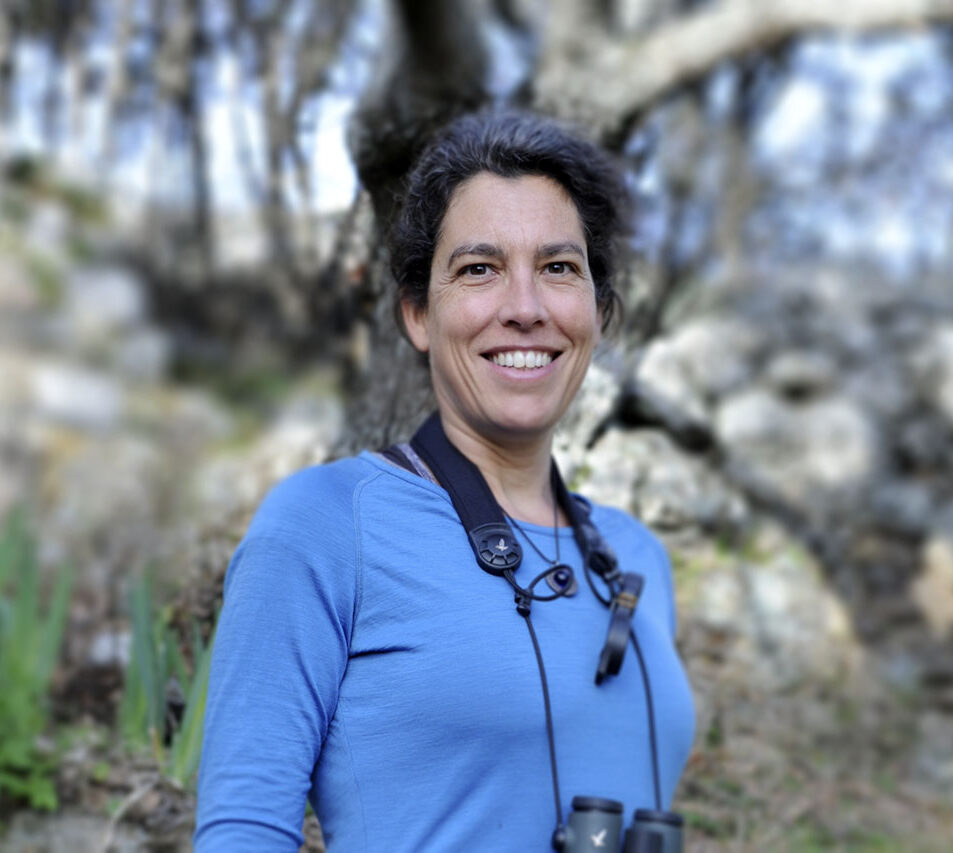Anne Charmantier: working hard on chickadees
In charge of a long-term study program on chickadees, Anne Charmantier is interested in how these passerines adapt to climate change and the urban environment. Director of research in evolutionary ecology at CEFE, she is a 2024 CNRS silver medalist.

As a child, Anne Charmantier dreamed of working with whales and polar bears. The daughter of "early environmentalists, " both Professors UM, she was not mistaken about her vocation. Except that she would ultimately work with chickadees. Since her university studies in evolutionary ecology, passerines have been a constant presence in her life. During her DEA (Master's degree), she contributed to the long-term study program on blue tits and great tits, launched in 1976 in the south of France and Corsica. Today, as director of research in evolutionary genetics at CEFE, she is in charge of this program. With a radiant smile earned during a field trip to Corsica the day before, she saysshe"understands the importance and responsibility of continuing this monitoring work at five sites, which involves seven permanent researchers and about 20 people in the field each year."
This year's CNRS Silver Medal winner quotes Newton: "If I have seen further, it is because I have stood on the shoulders of giants." One of her giants is Jacques Blondel, a leading ecologist and pioneer of the evolutionary ecology approach, who launched the chickadee program a year before she was born. Anne Charmantier does not boast about this silver medal: "I regret the personalization of the award. I love research because it involves asking questions together and I can rely on collaborations to find the answers." " The researcher is keen to ensure that her portrait gives due credit to her many collaborations. She talks about the "journal clubs" she regularly organizes with colleagues and students. During these coffee-and-reading sessions based on a recent scientific publication, everyone shares their thoughts and discusses the new findings.
Infidelity of chickadees
In her thesis, Anne Charmantier obtained unexpected results, notably discovering that chickadees are unfaithful. By studying the genome of broods, she found that in many nests, at least one chick has a biological father who is different from the social father who is raising it. This finding contradicts the monogamous behavior of this bird, at least as observed in gardens, where chickadees live in pairs and share the tasks of building nests and feeding their young. "I wondered why females were unfaithful and mated with other males, usually nearby. Do they choose them based on specific criteria, on traits that their partner does not possess?" This hypothesis of "good genes" being important for the species, which individuals would identify and favor in their reproductive practices, has not been confirmed. But the introduction of evolutionary genetics into the chickadee program is well underway.
Her specialization in quantitative genetics led to her being hired by the CNRS in 2006 at the age of just 29. "Thanks to a Marie Curie fellowship during my thesis, I was welcomed at the University of Edinburgh by Loeske Kruuk, a specialist in quantitative genetics applied to wild species. It was a new specialty in France, because in the early 2000s this discipline was reserved for agronomic genetic selection. Her collaboration with her British mentor continued until the publication in 2014 of a book on the contribution of quantitative genetics to evolutionary ecology. With this approach, Anne Charmantier will pursue two main areas of research: studying how passerines adapt to climate change and how they evolve in urban environments.
Early chickadees
One of her major findings concerns the adaptation of reproduction to global warming. Chickadees lay their eggs earlier in warmer years, which is necessary in order to feed their young with juicy caterpillars that are available just after the trees bud. Missing the season jeopardizes the survival of the chicks. "If chickadees don't catch on to the early spring, it will be a disaster for the broods," explains the researcher. Thanks to the genetic study of chickadee populations, which the researcher carries out "using tiny blood samples; a non-invasive blood sample of 10 microliters taken from the neck, " she confirms that early egg-laying and plasticity, or the ability to adapt the laying date to spring signals, are passed on from one generation to the next through the bird's genetic heritage. And evolution favors these two traits in chickadees. Natural selection favoring early-laying chickadees is even more pronounced, by about 40%, during a spring heat wave, explains the scientist.
More recently, Anne Charmantier has also turned her attention to the adaptation of chickadees to urban environments. "More out of necessity than a desire to give up working in the wild. But two young children and health problems prompted me to install nesting boxes in the city," says the researcher, squinting at a photo of a Corsican mountain range displayed in her office. Together with two colleagues from CEFE, Arnaud Grégoire and Marcel Lambrechts, she has developed a passion for this research, as urban chickadees differ from their forest counterparts in many ways.
"A communal garden where young chickadees are raised"
Their work shows that these individuals are smaller, duller in color, lay fewer eggs, are more aggressive, but also more exploratory. To understand whether these traits are acquired or not, the team launched a project in the nursery at Lunaret Zoo, "a communal garden where young chickadees are raised from eggs collected in both urban and forest environments. There is indeed a genetic transmission of the characteristics observed, because even though all the young birds are raised in the same conditions, they retain certain characteristics associated with their environment." The researcher explains the scale of the task: "It's a time-consuming project because the chicks have to be fed continuously from 7 a.m. to 9 p.m. every day for three months!"
In 2023, Anne Charmantier secured nearly €700,000 in ANR funding to study the interactive effects of urbanization and climate change in the Acacia project. "For example, urban chickadees are exposed to urban heat islands. Studying them can help us understand how they adapt—or fail to adapt—to global warming," she explains. She is conducting this study in collaboration with her colleague Samuel Caro, a specialist in bird ecophysiology, with whom she will test their thermoregulatory abilities in particular. And as if that weren't enough, the researcher is involved in an educational project in partnership with Lirdef (Interdisciplinary Laboratory for Research in Didactics, Education, and Training). She is now installing nesting boxes with on-board cameras in several schools in Montpellier and Paris to allow children to follow the lives of chickadees in the playground. "The idea is to test whether learning biology through the chickadee as a subject rather than an object helps develop a different relationship with nature," explains the inexhaustible researcher. Results will be available at the end of the school year.
